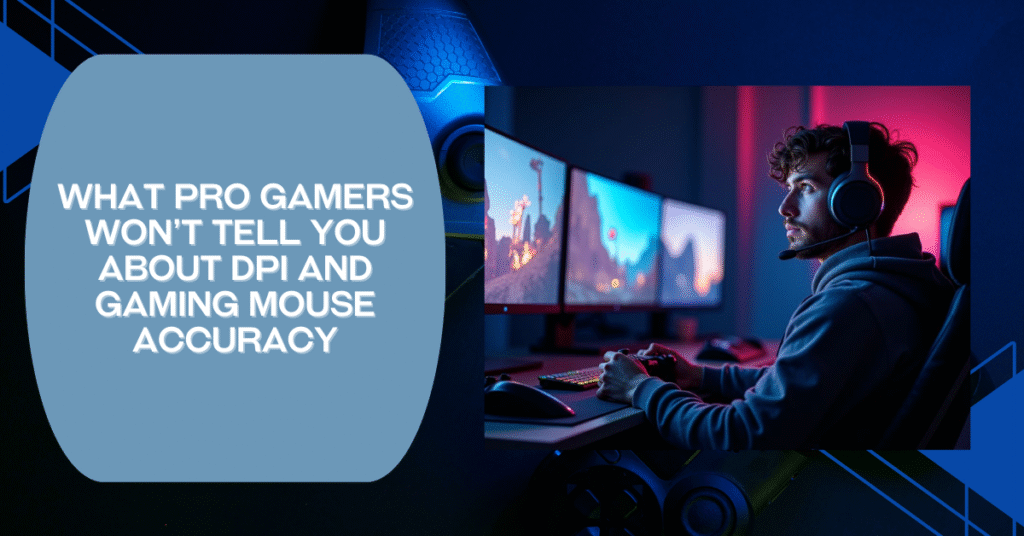“I swear I shot first!”
If you’ve ever yelled that at your monitor mid-match, welcome to the club. You’re not alone. I’ve rage-quit Warzone, thrown shade in Valorant, and had my fair share of “how did I miss that?” moments.
Back in 2021, I saved up for a flashy gaming mouse with a bazillion DPI settings and more RGB than a rave party. I thought I’d be hitting headshots like Shroud. Spoiler: I wasn’t. And that’s when I realized—nobody really talks about the truth behind DPI and mouse accuracy. Especially the pros.
So, let’s spill the tea, shall we?
The DPI Dilemma: What Even Is It?
Let’s get one thing straight—DPI stands for Dots Per Inch. Basically, it tells you how sensitive your mouse is. The higher the DPI, the faster your cursor will travel across your screen just by moving your hand a fraction of a millimeter.
Non-complex terminology is beautiful, right? Not so fast.
Here’s where it gets juicy: higher DPI doesn’t mean better aim. In fact, it can mess you up big time, especially if you’re not used to it. Your muscle memory goes out the window faster than a noob in Apex Legends.
I once set my DPI to 16,000 because, well, if the mouse offers it, why not use it? My crosshair was bouncing everywhere and I was overshooting every flick. My kill-death ratio dropped faster than crypto in 2022.

So why don’t pro gamers warn us?
Because they’ve already mastered their perfect DPI sweet spot—and they rarely change it. But you? You’re probably new and figuring things out and that is ok. Seriously, no shame in that!
Why High DPI Feels Like Driving a Ferrari on Ice
Let me paint a picture: imagine trying to drive a Ferrari in a snowstorm (hello, fellow Canadians, you feel me?). That’s what playing on ultra-high DPI feels like. Fast, unpredictable, and begging for a crash.
When your DPI is too high:
- Your aim becomes twitchy.
- Micro-adjustments are nearly impossible.
- You constantly overcorrect during a gunfight.
You’ll be like: “Why am I aiming next to the head instead of on it?”
That was me. I thought the problem was me. Turns out, it was my ridiculous DPI setting.
The Sweet Spot: What DPI Should You Use?
Here’s the truth bomb most pros won’t drop: lower DPI = more control.
Most esports players (especially in CS:GO, VALORANT, and Apex) play between 400 and 800 DPI, then tweak the in-game sensitivity to their liking.
Surprised? I was too. We all assume “bigger number = better performance,” but not in this case. Lower DPI gives you room for smooth tracking and pixel-precise shots.
And if you’re Canadian like me dealing with limited desk space in your basement battlestation—try combining low DPI + a larger mousepad. Trust me, that combo is .
It’s Not Just DPI—Sensor Quality Matters More
Here’s the part no one told me until I wasted money on a flashy-looking mouse: accuracy isn’t just about DPI. It’s about the sensor.
Many budget mice inflate their DPI numbers just for marketing. “20,000 DPI!” sounds cool, but if the sensor skips or jitters, it’s pointless. You wouldn’t buy a sports car with a wonky steering wheel, right?
Look for mice with PixArt sensors like:
- PMW3360
- PMW3389
- PAW3395 (super popular right now)
They track better, especially during fast flicks and low-sense gameplay.
My Turning Point: When I Ditched High DPI
Okay, real talk.
After months of missing shots, I dropped my DPI from 12,000 to 800 and adjusted my sensitivity in-game. I also grabbed a decent cloth mousepad, stopped blaming lag (okay, mostly), and focused on aim training.
Once I dialed in my DPI, it was like night and day. I began winning 1v1s, getting headshots and finally ranking up in Valorant. My crosshair wasn’t bouncing around like it consumed five cups of coffee anymore. It was locked in.
I felt like I cracked the code. The big secret? Consistency > Speed.
Muscle Memory: Your Real MVP
Let’s talk science, just for a sec (I promise it’s painless).
Your brain builds muscle memory through repetition. If your DPI and sensitivity are all over the place, your hands can’t build solid muscle memory. That’s why being consistent matters more than just having high speed or flashy features.
Pro tip? Pick a DPI/sens combo and stick to it for at least a couple of weeks. Don’t keep tweaking it every time you lose a match. (I used to do this all the time—guilty!)
Tuning Your Settings Like a Pro (Without Being One)
Here’s a simple way to fine-tune your setup without the guesswork:
- Start with 800 DPI.
- Set in-game sensitivity to something around 0.5–1.0.
- Do some aim training (Kovaak’s or Aim Lab).
- Adjust ONLY if you feel genuinely uncomfortable.
Also: test out settings during casual matches or deathmatch, not ranked. No one wants to be the guinea pig during clutch rounds, right?
Bonus Tip for Fellow Canadians: Watch Out for Cold Hands!
Weird advice? Maybe. But if you game in colder parts of Canada (hello, Alberta winters), cold hands can mess up your aim. No joke.
I keep a tiny heater under my desk, and I swear it’s improved my gameplay. Warm fingers = smoother flicks. Little things make a big difference.
Let’s Bust Some DPI Myths (Because They’re Everywhere)
Myth 1: Higher DPI = Better Mouse
False. It’s marketing fluff. Focus on sensor quality.
Myth 2: Real pros use max DPI
Nope. Most use 400–800 DPI. Ask around.
Myth 3: Changing DPI improves aim
Not unless your sensitivity is consistent. Most aim issues come from poor muscle memory, not DPI.
Final Thoughts: It’s Not About the Gear, It’s About You
In the end, a mouse or a setting won’t change anything. What counts is how well you adapt to your setup and how consistent you are with whatever you’re using.
So, if you’ve been road-dogging the perfect aim grind with different DPI settings, maybe it’s time to take a break. Find out what works for you, and stick with it so your hands can learn the cadence.
Gaming is like learning an instrument, you don’t change guitars every 10 minutes and expect to nail a song. Same goes for aim.
And if you’re Canadian like me, you’re already dealing with winter mood and lagging internet. Don’t let a jittery DPI setting change your entire game night!
TL;DR: Quick Recap for the Clickers
- DPI = mouse sensitivity; not the holy grail.
- Lower DPI (400–800) gives better accuracy and control.
- Sensor quality matters more than high DPI numbers.
- Stick to one setting to build muscle memory.
- Cold hands are real. Keep ’em warm!
- Fancy gear won’t fix bad habits—practice will.

Leave a Reply